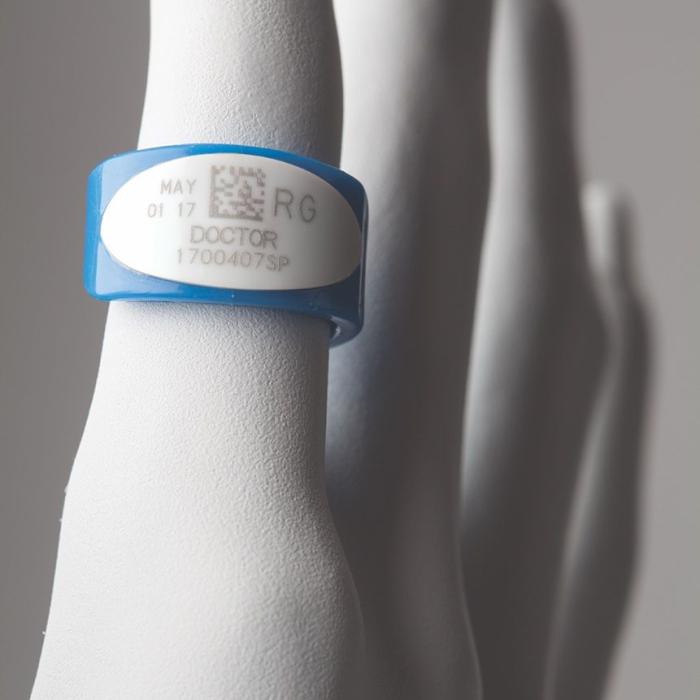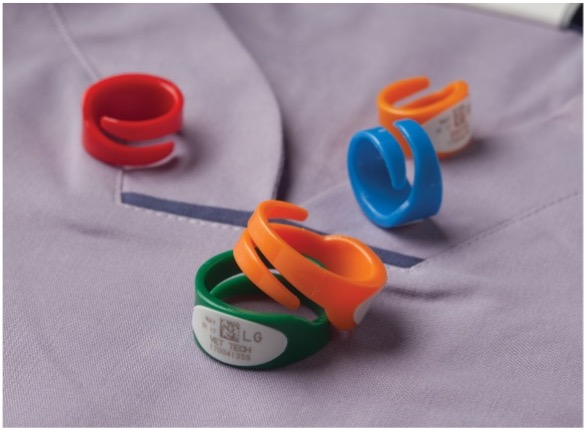
Saturn® Ring Dosimeter for Extremity Radiation Monitoring
The Saturn Ring Dosimeter utilizes Thermoluminescent dosimetry (TLD) technology, a widely trusted method for measuring ionizing radiation exposure. This dosimeter consists of a small, durable ring worn by workers in environments that utilize ionizing radiation, particularly when the source is near their hand(s).
Advantages & Benefits of the Saturn Ring Dosimeter
The Saturn Ring Dosimeter stands out for its versatility and user-friendly features. 
Flexible fit for unequalled comfort: The Saturn Ring is designed to provide maximum comfort to the wearer. Available in three sizes, the flexible design is adjustable, accommodating a wide range of users comfortably, even during long hours of use.
Precise reading with a minimum reportable dose of 10 mrem: The Saturn ring dosimeter offers precise readings, allowing for accurate measurement of radiation exposure. It has a minimum reportable dose of 10 mrem, ensuring reliable results.
2D barcode for easy scanning into myLDR: The Saturn TLD Ring features a 2D barcode that enables easy scanning into myLDR. This simplifies the process of tracking and managing radiation exposure data.
Advanced design for safety and durability: The TLD chip of the Saturn ring is safely encapsulated underneath the ring cap, which is ultrasonically welded to the ring base. This design ensures that the chain of custody between the chip and the wearer is always maintained. The cap is laser engraved, preventing the print from smearing, peeling, or washing off. The ring can be worn in both dry and wet working conditions, and its smooth edges allow it to fit inside surgical gloves without tearing them.
Disinfectable materials for hygienic environments: The Saturn ring is easy to clean, ensuring proper cleanliness is maintained in environments that require high levels of hygiene.
How Does the Saturn Ring Dosimeter Work?

When exposed to ionizing radiation, the crystalline materials within the dosimeter trap some of the energy. Later, during analysis, the crystals are heated, causing the trapped energy to be released as light. The intensity of this light is directly proportional to the amount of radiation absorbed by the dosimeter, providing accurate data on individual exposure levels. This reliable technology ensures effective monitoring of radiation doses, crucial for maintaining safety standards in various occupational settings, including medical imaging facilities, cath labs, nuclear facilities, and industrial environments.
Saturn Ring Dosimeter Specifications
The Saturn dosimeter ring is the highest efficiency dosimeter made with natural lithium fluoride.
It measures exposure due to X, beta, and gamma radiation using Thermoluminescent technology. The energy range for photon (X or gamma ray) is greater than 15 keV, while the average energy for beta particles is greater than 200 keV. The dose measurement range for photon (x or gamma ray) and beta particles is 10 mrem to 1,000 rem (100 μSV to 10 SV).
The Saturn ring is accredited by NVLAP for ANSI N13.32-2008 categories IB, IC, IIB, IIC, IID, IIIB, IIIC, IIID, and IVBB.
Technical Specifications
The Saturn ring is the highest efficiency dosimeter with all-natural lithium fluoride.
| Property | Value |
| Energy Range | Photon (x or gamma ray) - greater than 15 keV |
| Dose Measurement Range |
|
| Accreditation | The Saturn ring is accredited by NVLAP for ANSI N13.32-2008 categories IB, IC, IIB, IIC, IID, IIIB, IIIC, IIID, and IVBB. |
Saturn Ring Dosimeter FAQs
Who should wear a Saturn dosimeter ring?
The Saturn dosimeter ring should be worn by workers who must manually manipulate or work near radioactive materials and radiation producing equipment. It is designed to provide comprehensive extremity radiation monitoring.
When should a Saturn ring dosimeter be worn?
Saturn rings should be worn during work activities involving handling or working near radioactive materials and radiation producing equipment. They are specifically designed to measure exposure due to x, beta, and gamma radiation.
Should a dosimeter badge also be worn at the same time?
Yes, it is recommended to wear a dosimeter badge in addition to the dosimeter ring. The dosimeter badge provides whole-body radiation monitoring, while the dosimeter ring focuses on extremity radiation monitoring. Wearing both types of dosimeters ensures comprehensive radiation monitoring for the worker.
What is the lowest mrem Saturn ring can detect?
The lowest mrem the ring can detect is 10 mrem.
What sizes does the Saturn ring come in?
The ring comes in three adjustable sizes: small/medium, large, and extra large.
What do the different colors mean?
The different ring colors help organizations ensure participants are wearing the ring that aligns with the current wear period.
Can the Saturn ring be cleaned?
Yes. Saturn rings can be cleaned, disinfected, and sterilized. Detailed information can be found here.
How do I keep track of whose ring is whose?
To ensure the ring is worn by the correct individual, the ring is labeled with the wearer's name, the ring serial number, begin wear date, left or right hand, and exchange frequency. It also has a 2D barcode for scanning.
Is there a control dosimeter ring?
Yes, there is a control dosimeter ring. Control ring dosimeters are distinguishable by the yellow label and red base.
Where should I keep the control dosimeter?
Control dosimeters should be kept away from radiation sources. We recommend storing the control dosimeter in the same location that your other dosimeters are stored between shifts.
